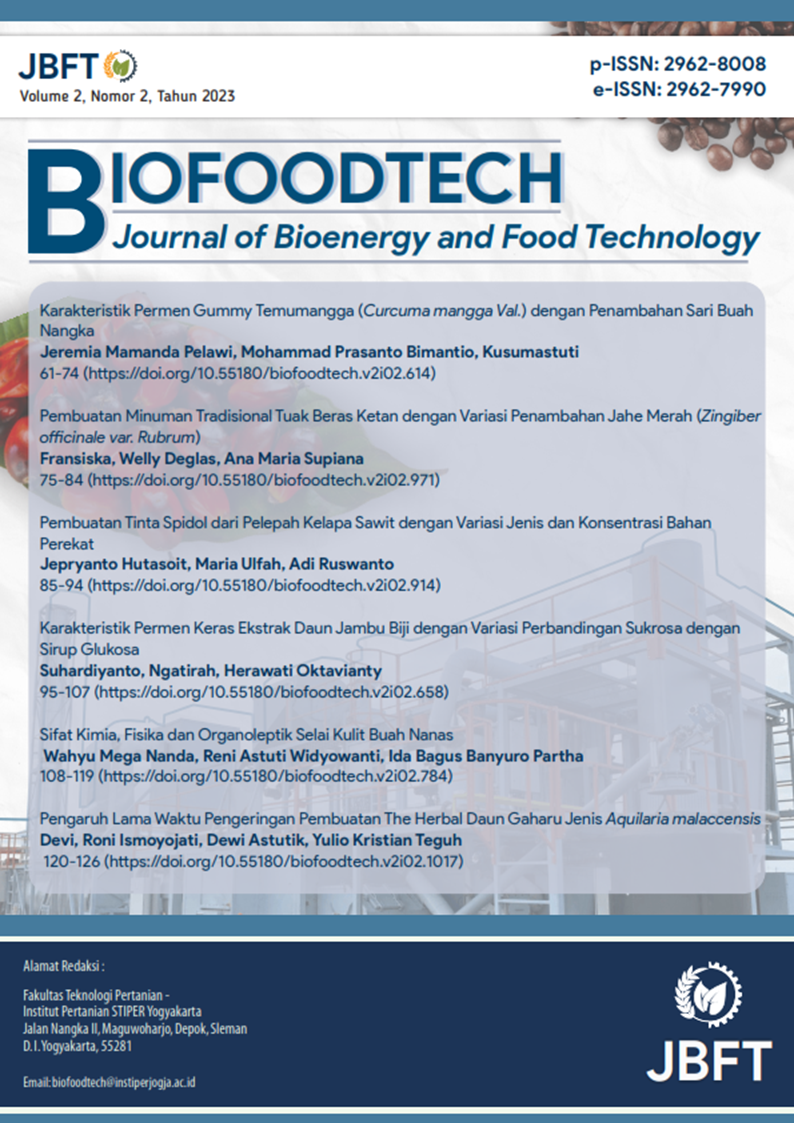Pembuatan Tinta Spidol dari Pelepah Kelapa Sawit dengan Variasi Jenis dan Konsentrasi Bahan Perekat
DOI:
https://doi.org/10.55180/biofoodtech.v2i02.914Kata Kunci:
marker ink, palm fronds, gum arabic, tapioca flour, porang flourAbstrak
Marker ink dyes are generally made from synthetic materials, including anthraquinone which is corrosive and causes irritation to the skin. It is hoped that the marker ink dye from palm frond fiber can overcome this problem. Ink made from carbon fiber from palm fronds to be able to stick to a whiteboard requires adhesive materials including gum arabic, tapioca flour and porang flour. This research aimed to determine the effect of the type and amount of adhesive on the physical and organoleptic properties of marker ink from palm frond carbon produced, as well as to obtain the type of adhesive and amount of adhesive that is capable of producing good marker ink. This research was designed using a Randomized Complete Block Design (RCBD) with two variable factors. The first factor is the comparison of adhesive types (A) with 3 levels, including: A1 (gum arabic), A2 (tapioca flour), A3 (porang flour). The second factor is the amount of adhesive (B) with 3 levels, including: B1 (10%), B2 (20%), B3 (30%). The results showed that the type of adhesive had an effect on density, viscosity, light intensity and adhesion, but had no effect on color preference, ease of removal and odor preference. The amount of adhesive affects density, viscosity, light intensity and adhesion, but does not affect color preference, ease of removal and odor preference. The best ink was obtained from A1B1 treatment with an average consumer acceptance value of 3.80 (like), density 0.94 g/m3, viscosity 15.60 cP, light intensity 0.23 lux, adhesion 13.01%.
Referensi
Anova, I. T., & Muchtar, H. (2017). Pemanfaatan Gambir sebagai Bahan Dasar Pembuat Tinta Spidol Ramah Lingkungan. Jurnal Litbang Industri, 7(2), Article 2. https://doi.org/10.24960/jli.v7i2.3368.101-109
Christiana, M., Radiati, L., & Purwadi, P. (2015). Pengaruh Gum Arab Pada Minuman Madu Sari Apel Ditinjau Dari Mutu Organoleptik, Warna, pH, Viskositas, dan Kekeruhan. Jurnal Ilmu dan Teknologi Hasil Ternak, 10(2), 46–53. https://doi.org/10.21776/ub.jitek.2015.010.02.5
Imam, R. H., Primaniyarta, M., & Palupi, N. S. (2014). Konsistensi Mutu Pilus Tepung Tapioka: Identifikasi Parameter Utama Penentu Kerenyahan. Jurnal Mutu Pangan, 1(2), 91–99.
J.P, A. P., S, D. J. D. H., & Masruroh, M. (2012). Pengaruh Konsentrasi Dan Viskositas Larutan Polistiren Terhadap Morfologi Permukaan Dan Ketebalan Lapisan Znpc Pada Permukaan QCM. 1. https://www.neliti.com/id/publications/158964/
Liu, W., Zhao, T., Zhang, Y., Wang, H., & Yu, M. (2006). The Physical Properties of Aqueous Solutions of the Ionic Liquid. Journal of Solution Chemistry, 35(10), 1337–1346. https://doi.org/10.1007/s10953-006-9064-7
Pratama, Y. A., Juhara, S., & Kurniasari, R. (2022). Efektivitas Limbah Kulit Bawang Putih Sebagai Pigmen Organik Dalam Pembuatan Tinta Spidol. Unistek: Jurnal Pendidikan dan Aplikasi Industri, 9(2), Article 2. https://doi.org/10.33592/unistek.v9i2.2796
Rahayu, T. F., & Fatimah, S. (2021). Pengaruh Variasi Konsentrasi Karbon Tempurung Kelapa Terhadap Karakteristik Tinta Spidol Whiteboard Ramah Lingkungan. Jurnal Kartika Kimia, 4(2), 77–82. https://doi.org/10.26874/jkk.v4i2.86
Rengganis, A. P., Sulhadi, S., Darsono, T., & Fajar, D. P. (2017). FABRIKASI TINTA SPIDOL WHITEBOARD BERBAHAN DASAR PIGMEN ORGANIK DARI ENDAPAN MINUMAN KOPI. PROSIDING SEMINAR NASIONAL FISIKA (E-JOURNAL), 6, 105–112. https://doi.org/10.21009/03.SNF2017.02.MPS.17
Salam, R. (2017). Uji keapatan,viskositas dan tegangan permukaan pada tinta print dengan bahan dasar arang sabut kelapa, [UIN Alauddin Makassar]. https://repositori.uin-alauddin.ac.id/9991/
Sitorus, M. F., Komalasari, K., & Helwani, Z. (2017). Karbonisasi Pelepah Sawit Dengan Variasi Temperatur Dan Waktu Karbonisasi. Jurnal Online Mahasiswa (JOM) Bidang Teknik dan Sains, 4(1), Article 1.
Sulastri, T. (2018). Pengaruh Konsentrasi Maltodekstrin Terhadap Kadar Likopen Dan Mutu Organoleptik Serbuk Tomat Instan. Ilmu Dan Teknologi Pangan, 1–14.
Wiguna, P. A., & Susanto, S. (2015). PEMBUATAN TINTA PRINTER DENGAN PIGMEN ORGANIK BERBAHAN DASAR SAMPAH DAUN. Sainteknol : Jurnal Sains Dan Teknologi, 13(2), Article 2. https://doi.org/10.15294/sainteknol.v13i2.5247
Unduhan
Diterbitkan
Cara Mengutip
Terbitan
Bagian
Citation Check
Lisensi
Hak Cipta (c) 2023 BIOFOODTECH : Journal of Bioenergy and Food Technology

Artikel ini berlisensiCreative Commons Attribution-NonCommercial-ShareAlike 4.0 International License.











